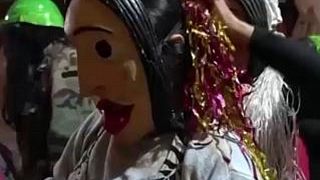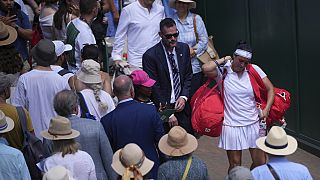United Kingdom
'Three Architects' is typical of Lubaina Himid's style: A vividly-coloured figurative painting that centres Black characters.
But there's much more to the veteran artist, and this solo exhibition at London's Tate Modern hopes to showcase her full breadth.
She's been a pivotal figure in the Black British arts movement for decades, work from the very start of her career all the way up to modern day is on display.
There are 50 works, covering her most famous paintings, poetry, everyday objects that she has transformed with her signature bright style, even sound installations.
"This is an exciting opportunity for the public to see the largest show of Lubaina Himid's work," says curator Michael Wellen.
"She's been working since the 1980s, is best known for painting, and she paints not only on canvas, but on all sorts of materials: on furniture, on ceramics, on cutouts that she's made. And this is an opportunity to be immersed in her painting."
Himid is Professor of Modern Art at the University of Central Lancashire.
She won the Turner Prize in 2017, becoming the first Black woman to clinch the prestigious award.
This exhibit asks viewers to consider several questions: From the whimsical 'what does love sound like?' to the practical issue of whether the clothes we wear and buildings we live in actually fit us.
After close to two years of living in a pandemic, some of these queries are more relevant than ever, says assistant curator Amrita Dhallu.
"This exhibition is a super important one, because it really seeks to place the audience at the centre of all of its action. Especially after the kind of year that we've had this year, it seems so important because it asks of us lots of questions about our daily encounters with everything that shapes and changes our lives," she says.
Himid first created the installation 'A Fashionable Marriage' back in 1984.
The characters represented in it reflect the political landscape of the time, the work also reflects the theatre.
She began her career training in theatre design.
"Lubaina Himid's career is very much rooted in her background in theatre, so the experience you have in the exhibition is one that is quite theatrical and one that really draws on the drama of everyday life," explains Dhallu.
"So, throughout the show, Lubaina has placed these beautiful questions throughout the space, which asks the audience about their relationship to the built environment, the clothes they wear, the objects that they hold dear."
A much more recent work is 'Blue Grid Test'.
The installation was only produced last year (2020), this is the first time it's been shown in the UK.
The 25-metre-long work lines the walls of one room in the exhibit, Himid's voice can be heard reciting various ideas about the colour 'blue' in English, French and Flemish.
It was created with sound artist Magda Stawarska-Beavan.
"The two were working together to figure out how they could represent sound visually and how they could represent memory through sound. So, around this room are 64 paintings, each corresponding to a bar of music from the song Blue by Joni Mitchell. And the patterns are painted onto objects from the artist's home: books, bed frame, old musical instruments," says Wellen.
'The Operating Table' is one of six new paintings having their premiere at the exhibit.
It explores women's creativity, as the characters are caught in the middle of a conversation and planning.
For art critic Tabish Khan, this exhibit is a chance to understand the artist better.
"She is the oldest person to have won the Turner Prize, and she's got many decades of creating work without getting the recognition she deserves, which she's getting through this show," he says.
"But it's great to see such a variety of her work because if you just see an individual painting, you won't be able to put her work into context. While here we have references to theatre, there's poetry on the walls, there are paintings and there's music as well."
At the start of her career, Himid felt Black artists were largely ignored by the rest of the world.
Forty years later, that's perhaps changing.
"I think we have seen a major change in the recognition of Black artists, we've seen it at Tate with Frank Bowling a few years ago, him getting a retrospective after many, many decades of producing work, and we're seeing it more and more," says Khan.
"It's a positive step. We need to see more of Black artists and wider representation within Tate exhibitions."
Lubaina Himid's solo exhibition opens on 25 November and runs until 3 July 2022.













Go to video
Morocco: United Kingdom withdraws from renewable energy project
Go to video
Chagos deal backlash: UK under fire over £30 billion payout
02:20
In Brazil, knights and masked riders take to a football pitch for religious festival
01:59
Algerian international player, Rayan Ait-Nouri, joins Manchester City
01:00
Interact with art in 'Euphoria: Art is in the Air' at Grand Palais
01:15
Gaza officials say Israel kills more than 30 people near aid distribution site